H-Base for a Water
Rocket Launcher
A H Base
has the advantage that if the ground where you
are launching is too hard to push a stake in, you
can still set up your launcher. They are also
lighter, and, arguably less dangerous.
Design
Considerations
With summer aproaching, I decided to have a go at
making a H Base for the launcher. The stake base,
using the swing ball base is heavy and makes the
launcher long to carry and taking into account the
spike, fairly dangerous (thinking of someone falling
on it while carrying it to the launch site). It is
also difficult to drive into hard earth and in soft
earth, is not as stable as I would like.
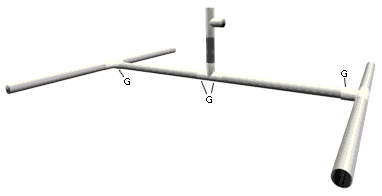
The H Base is made from 21.5mm od white PVC
overflow pipe (the grey 22mm od overflow pipe will do
although it is a little more difficult to assemble
the base) with 'T' pieces to fix the bits together.
Conection to the bottom of the business part of the
launcher should be as easy and as reliable as
possible.
Parts
To make one, you will need . . .
- 3 metres of 21.5mm od PVC overflow pipe;
- 4 'T' pieces;
- 2 Jubilee clips;
- A Dog restraint screw (optional);
- a pipe cutter (a pipe cutter won't cut the
grey pipe very well but manages the white PVC
pipe with little problem); and,
- a Stanley knife.
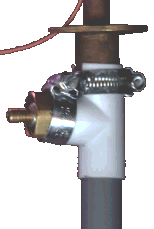 Construction Construction
You need to have 6 equal lengths of PVC pipe and a
short stem to mount the launcher on. I used around
6" (15cm) of grey pipe for the launcher stem but
you can use the white pipe for this. Once you have
cut your stem, divide the rest of the pipe equally
into six using the pipe cutter or Stanley knife - if
the latter, making sure that the ends are cut
squarely.
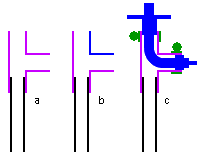 Assemble
the pipes with the 'T' pieces as in the diagram
upper-right. To make it more stable (if you are going
to launch a lot of heavy rockets), you can glue the
joints marked 'G' - the joints fixing the cross bar
of the H - taking care not to get glue on the other
joints. Doing this will allow you to dismantle the
base and pack it into a small volume suitable for
carrying to the launch site by a child/slave/ground
crew member, or by tying to a bicycle. If you are not
going to use glue, then, whenever you dismantle the
base, always leave the joints marked 'G' in place -
doing this will not give them the opportunity to wear
loose. The joints marked 'G' carry all of the
rotational forces whereas the others are bending
forces. Assemble
the pipes with the 'T' pieces as in the diagram
upper-right. To make it more stable (if you are going
to launch a lot of heavy rockets), you can glue the
joints marked 'G' - the joints fixing the cross bar
of the H - taking care not to get glue on the other
joints. Doing this will allow you to dismantle the
base and pack it into a small volume suitable for
carrying to the launch site by a child/slave/ground
crew member, or by tying to a bicycle. If you are not
going to use glue, then, whenever you dismantle the
base, always leave the joints marked 'G' in place -
doing this will not give them the opportunity to wear
loose. The joints marked 'G' carry all of the
rotational forces whereas the others are bending
forces.
To fix the launcher (my Copper Tube Launcher with
its 90º elbow at the bottom) 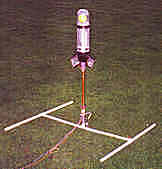 to the H-Base,
start off with the short, vertical pipe in one of the
T pieces as in diagram a
above-left (this will give you something to hold it
with during the next step and make that operation
safer for you. Very carefully, and using the Stanley
knife, and, only cutting away from yourself, cut the
part in digram b
that is coloured blue so as to create a slit in the
tube through which you can put the elbow of the
launcher - just separate the two sides, there is no
need to remove any material. to the H-Base,
start off with the short, vertical pipe in one of the
T pieces as in diagram a
above-left (this will give you something to hold it
with during the next step and make that operation
safer for you. Very carefully, and using the Stanley
knife, and, only cutting away from yourself, cut the
part in digram b
that is coloured blue so as to create a slit in the
tube through which you can put the elbow of the
launcher - just separate the two sides, there is no
need to remove any material.
Once 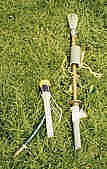 you
have your slit, push the bottom of the launcher into
the tube as in diagram c
and then secure the launcher with Jubilee clips to
make it sturdy. With the short piece of tube on the
bottom, this can now fit into the H-Base that you
have made. you
have your slit, push the bottom of the launcher into
the tube as in diagram c
and then secure the launcher with Jubilee clips to
make it sturdy. With the short piece of tube on the
bottom, this can now fit into the H-Base that you
have made.
To use any other launcher, you simply need it to
have a length of pvc tube to attach it to the base as
in the photograph on the left, showing the copper
tube launcher and the hose connector launcher.
Use
- At the site, assemble the H-Base as shown in
the picture at the top of the page except for
the central, vertical piece with the launcher
attached to it;
- Fill the rocket to the desired level and
secure rocket to the launcher with launch
tube if used;
- Turn the rocket with the launcher attached
the right way up and then push the launcher's
tube onto the T piece at the centre of the
H-Base as in the picture at the top of the
page.
- Pressurise and launch in the normal way.
Note that you should run the release string so
that it is parallel with the cross-bar of the H-Base
so that when you pull the release string, there are
no twisting forces on the joints of the launcher base
- only bending forces.
Variations
One problem 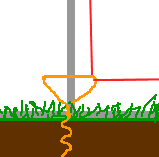 is
that the launcher is quite light and there is nothing
fixing it to the ground other than gravity. When the
release string is pulled sharply, it can lead to the
launcher being pulled to one side resulting in a
possible mis-firing of the rocket. is
that the launcher is quite light and there is nothing
fixing it to the ground other than gravity. When the
release string is pulled sharply, it can lead to the
launcher being pulled to one side resulting in a
possible mis-firing of the rocket.
One solution to this problem is to use a tent peg
or one of the corkscrew type dog securing skewers
that you can use to secure a dog to a lawn. Knock the
peg or screw the skewer into the ground and position
the launcher over it so that the launch release
string passes down through the metal loop. This will
result in the only forces acting on the launcher to
be downwards thus preventing a sidways movement at
launch. Although this is sharper than the stake, it
is nothing like as long and may also be protected
(perhaps this should read 'the users may be protected
from the point') by putting a suitable cork on the
end of the point.
 Back to the Launcher Index Back to the Launcher Index
 Back to the Water Rocket Index Back to the Water Rocket Index
|

 Construction
Construction Assemble
the pipes with the 'T' pieces as in the diagram
upper-right. To make it more stable (if you are going
to launch a lot of heavy rockets), you can glue the
joints marked 'G' - the joints fixing the cross bar
of the H - taking care not to get glue on the other
joints. Doing this will allow you to dismantle the
base and pack it into a small volume suitable for
carrying to the launch site by a child/slave/ground
crew member, or by tying to a bicycle. If you are not
going to use glue, then, whenever you dismantle the
base, always leave the joints marked 'G' in place -
doing this will not give them the opportunity to wear
loose. The joints marked 'G' carry all of the
rotational forces whereas the others are bending
forces.
Assemble
the pipes with the 'T' pieces as in the diagram
upper-right. To make it more stable (if you are going
to launch a lot of heavy rockets), you can glue the
joints marked 'G' - the joints fixing the cross bar
of the H - taking care not to get glue on the other
joints. Doing this will allow you to dismantle the
base and pack it into a small volume suitable for
carrying to the launch site by a child/slave/ground
crew member, or by tying to a bicycle. If you are not
going to use glue, then, whenever you dismantle the
base, always leave the joints marked 'G' in place -
doing this will not give them the opportunity to wear
loose. The joints marked 'G' carry all of the
rotational forces whereas the others are bending
forces. to the H-Base,
start off with the short, vertical pipe in one of the
T pieces as in diagram a
above-left (this will give you something to hold it
with during the next step and make that operation
safer for you. Very carefully, and using the Stanley
knife, and, only cutting away from yourself, cut the
part in digram b
that is coloured blue so as to create a slit in the
tube through which you can put the elbow of the
launcher - just separate the two sides, there is no
need to remove any material.
to the H-Base,
start off with the short, vertical pipe in one of the
T pieces as in diagram a
above-left (this will give you something to hold it
with during the next step and make that operation
safer for you. Very carefully, and using the Stanley
knife, and, only cutting away from yourself, cut the
part in digram b
that is coloured blue so as to create a slit in the
tube through which you can put the elbow of the
launcher - just separate the two sides, there is no
need to remove any material. you
have your slit, push the bottom of the launcher into
the tube as in diagram c
and then secure the launcher with Jubilee clips to
make it sturdy. With the short piece of tube on the
bottom, this can now fit into the H-Base that you
have made.
you
have your slit, push the bottom of the launcher into
the tube as in diagram c
and then secure the launcher with Jubilee clips to
make it sturdy. With the short piece of tube on the
bottom, this can now fit into the H-Base that you
have made. is
that the launcher is quite light and there is nothing
fixing it to the ground other than gravity. When the
release string is pulled sharply, it can lead to the
launcher being pulled to one side resulting in a
possible mis-firing of the rocket.
is
that the launcher is quite light and there is nothing
fixing it to the ground other than gravity. When the
release string is pulled sharply, it can lead to the
launcher being pulled to one side resulting in a
possible mis-firing of the rocket.